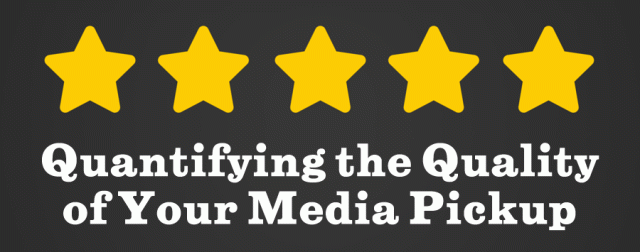| Lukas Alexander 
If I asked you to list out which audiences are central to your PR and marketing efforts, I bet it’d be safe to surmise your current and prospective customers are at the top. Somewhere on your list, though, will be your organization's executive team, investors, and other stakeholders. While your customers – and the media who influence them – should definitely be the cornerstone of your strategy, you won't receive more resources to optimize your efforts unless you have the buy-in of your company's leaders. And you can't get buy-in unless you can quantify your previous programs' success. For public relations campaigns, that has traditionally meant showcasing the number of brand mentions and impressions a particular press release or media relations pitch generated. However, high audience numbers on their own do not reflect all aspects of a campaign’s success. It's the quality of those numbers that has the power to impress your executive team, inspire increased investment, and inform effective action. As Melissa Toso writes in How to Prove Your PR's ROI with the Right Reporting, "Members of the C-suite, agency clients and other stakeholders all want to know whether the money, time and energy that went into a campaign changed consumer behavior and, more importantly, generated profit." Because of this, you can't take the quantity of media coverage at face value. Today's PR and marketing teams are called on to quantify the quality of their pickup, and there are three key areas in which this can be done. Scope of Media Pickup Your audience is everywhere and focusing on mentions and pickup from just one publication or channel won't accurately reflect your output's overall outcomes. In the whitepaper Brand Monitoring for the C-Suite: Delivering Actionable Business Intelligence, Ken Wincko, Senior Vice President of Marketing at PR Newswire, emphasizes the importance of measuring both online and offline channels. "To gain a 360-degree view of the media landscape, monitor the full range of media types that audiences consume and contribute to, including social media, blogs, print and online media; online ratings and reviews; television and radio broadcasting; and the effects of public relations outreach." Breaking down performance across social, mainstream, and niche media types will not only help uncover opportunities for growth, but also justify to your executive team why it's a smart decision to invest additional resources into the channels or campaign types that are proven winners. Representation of Brand Message "On a symbolic level, a brand is a business's personality—the characteristics customers think of when they think of the business," continues Ken in his white paper. To understand how your brand's personality is being represented and reinforced by journalists, influencers, and other third parties, you need to look beyond the number of mentions, shares and reposts and understand what is actually being said about you. What is your "share of voice" on important corporate topics or industry trends—i.e. how often is your name mentioned with those topics vs your competitors? How much of the coverage is positive, negative or neutral? How much action (traffic referral, shares, purchases, etc.) is the earned media driving? The answers to these questions demonstrate how effective you are at contributing to the conversations media and potential customers are having about your brand. 
Relevance of Media Outlets Ultimately, your media outreach and pickup should support business goals, such as growing your brand's qualified leads and closed sales. Having an article reach a large number of people doesn't guarantee a win. While there is value in reaching high-traffic outlets, you also want to make sure you balance this by reaching your audiences on the channels they care about. Because your audience's purchase decisions are influenced by the media they consume, the coverage you receive in targeted outlets should play a prominent role in your reporting. When it comes time to prove your PR's worth, you need to know which metrics will be the most accurate reflection of your efforts' impact on the bottom line. Download Brand Monitoring for the C-Suite: Delivering Actionable Business Intelligence for more advice on delivering comprehensive reports to your executives. Author Lukas Alexander is a media analyst on PR Newswire's professional services team, helping global customers with their monitoring and measurement. |